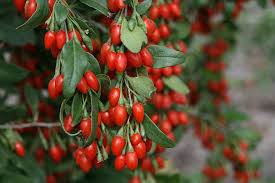Goji Berry, Lycium Sweet Lifeberry
Grow a healthy snack in your yard or garden - Goji berries are easy!
 Goji berries, Lycium barbarum, are all the rage among
healthy eaters and gardeners alike. Their new popular name is based on the
original Chinese name, Gou Qi Zi. Previous popularized names include Chinese Wolfberry, Matrimony Vine,
Chinese Boxthorn, Red Medlar and The Duke of Argyll's Tea Tree.
Goji berries, Lycium barbarum, are all the rage among
healthy eaters and gardeners alike. Their new popular name is based on the
original Chinese name, Gou Qi Zi. Previous popularized names include Chinese Wolfberry, Matrimony Vine,
Chinese Boxthorn, Red Medlar and The Duke of Argyll's Tea Tree.
The plants were
introduced into England’s gardening culture in the 1600s and the shrubs have
become naturalized around the country in hedgerows.
Spring Meadow Nursery (springmeadownursery.com/plant/55060) and Proven Winners (provenwinners.com/vitaminberries) are teaming up to make Goji
berries equally popular with home gardeners in the US.
While Goji berries are
said to have many nutritional benefits their commercial value to US agriculture
is somewhat limited because they have to be harvested by hand and spoil quickly.
As a result, Goji berries available to US consumers are primarily grown in
China and sold as dried fruit.
The plants
are easy to grow, are insect and disease free, and are suited to our climate so
they could be a good selection for an edible landscape. Birds, deer, and other
animals enjoy the abundant, sweet fruit, so it has to be protected with nets
and/or fencing.
The health claims for Goji berry fruit make it one of the Super Fruits.
The leaves, roots, bark, seeds and the fruit itself have been used medicinally by
the Chinese for a thousand years. The nutritional analysis indicates that they
are 13 percent
protein, contain 11
essential and 22 trace dietary minerals, 18 amino acids, antioxidants, more iron than spinach, more vitamin C than oranges, and more
beta-carotene than carrots.
There are dozens of stories about the health benefits of
Goji berries, also called Wolfberries. Explorers reported entire Chinese
villages free of illness and Master Li Chen Yuen was said to live to the age of
256 because of daily Goji berry snacking.
The
plants are cold hardy to USDA zone 5 and AHS heat zone 9. They enjoy full sun
but can take some shade. They start out growing like vines that have to be bundled
and staked or allowed to sprawl on the ground. Within a few years, the canes
grow into a shrub, maturing at 6 to 10 feet tall. In China, commercial growers use a 6-foot-tall
stake and space the plants about 5 feet apart.
Goji
berries thrive in well-drained soil, can tolerate drought after the first two
years of becoming established, and can take soil pH up to 7.5 to 8. They cannot
tolerate standing water or wet clay soil.
No
pruning is required but late-winter or early-spring pruning of the horizontal
branches will encourage branching and new growth. They can be grown on a
trellis or pruned into a tree-shape by selecting a main cane to serve as a
trunk.
The
white to light-purple trumpet flowers bloom from early summer to fall. The
plants are self-fertile and wind-pollinated so there is no need to have more
than one.
The
annual 2-pounds of fruit ripens at about ¾ of an inch long and with a deep
red-orange color. Ripe fruit is soft so hand picking is essential. One gardener
recommended laying down a sheet and gently shaking the plant to release the
fruit.
Once
the fruit is harvested is has to be served or frozen right away. Recipes
include smoothies, chocolate coating, dried for later use, etc.
Do
water but do not fertilize during the first year. The second spring add
fertilizer such as rose food. A 2-3-inch mulch of tree bark is recommended to
prevent weeds in the summer and soil heaving over the winter.
Goji
berry plants can be grown in containers, gradually moving a small plant into
larger containers until it matures into one the size of a half-barrel.



Comments